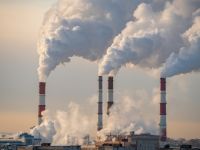Introduction:Poor natural resource management over many years and continuing high population growth have had a negative impact on Pakistan's environment.
Agricultural runoff--caused by ongoing deforestation--and industrial runoff have polluted water supplies, and factory and vehicle emissions have degraded air quality in the urban centers.
Please note: the material is updated until May 2000
Energy Consumption:
Pakistan's energy consumption has nearly tripled in the last 20 years. From 0.6 quadrillion Btu in 1980, Pakistan's total energy consumption in 1998 stood at 1.7 quads. Still, Pakistan accounts for only 0.5 percent of total world energy consumption.
In terms of per capita energy consumption, Pakistan's level of 12.3 million Btu in 1998 is higher than Bangladesh's (3.3 million Btu) but virtually on par with India's (12.9 million).
In comparison, China's per capita energy consumption in 1998 was 27.0 million Btu, Iran's was 72.4 million Btu, and Russia's was 177.3 million Btu, while U.S. per capita consumption was 350.7 million Btu.
Pakistan's energy consumption by sector shows that nearly half (49 percent) is attributed to residential. The industrial sector accounted for most of the rest with 33.5 percent, while transportation made up 13.2 percent and the commercial sector was responsible for 4.3 percent.
Energy consumption by fuel type showed that oil made up 43.5 percent, natural gas 38.3 percent, and coal just 5.1 percent.
Carbon and Energy-Related Emissions:
Pakistan's carbon emissions in 1998 totaled 26.8 million metric tons, nearly triple the 1980 level of 9.3 million metric tons.
Yet, Pakistan accounts for only 0.4 percent of the world's carbon emissions, and its emissions are relatively low compared to its neighbors in the region: Iran's emissions have climbed from 33.1 million metric tons of carbon in 1980 to 79.4 million metric tons in 1998, while India's carbon emissions have jumped from 82.2 million metric tons in 1980 to 252.6 million metric tons in 1998.
Because Pakistan, along with other developing countries, has argued that it needs to be free of emission ceilings in order to develop its economy, the country has not taken on any emission reduction commitments under the United Nations Framework Convention on Climate Change, nor is Pakistan a signatory to the Kyoto Protocol.
Pakistan's per capita carbon emissions in 1998 were 0.2 metric tons. In comparison, Bangladesh emitted 0.1 metric tons of carbon per person, while India's level was 0.3 metric tons per capita.
China's per capita carbon emissions level in 1998 was 0.6, Iran's level was 1.3, and the U.S. value was 5.5 metric tons per person.
Sectorally, Pakistan's carbon emissions mainly came from the industrial sector (45.1 percent), while transportation accounted for 27.1 percent, the residential sector for 22.3 percent, and the commercial sector 5.6 percent.
Of these emissions, oil was responsible for 56 percent, with natural gas (35.7 percent) and coal (8.3 percent) making up for the rest.
Energy and Carbon Intensity:
Pakistan's energy intensity--energy generated per dollar spent--is high due to the inefficiencies of the state-run power sector in generating electricity and transmitting it across the national grid.
Poor quality infrastructure, as well as power theft, means that Pakistan does not generate the amount of electricity it needs to, necessitating rotating blackouts.
In 1993, the World Bank estimated that 28 percent of the electricity generated in Pakistan was diverted illegally in transmission and distribution.
Although the Pakistani government put this figure at 12 percent, theft has nonetheless exacerbated the country's high energy intensity.
In 1998 Pakistan's energy intensity stood at 30,700 Btu/$1990--more than double the United States' energy intensity of 13,400 Btu/$1990 in 1998. In comparison to its neighbors, Pakistan's level of energy intensity was slightly higher.
Bangladesh's 1998 energy intensity was significantly lower at 13,200 Btu/$1990, while Iran (26,900 Btu/$1990) and India (27,203 Btu/$1990) were just below Pakistan and China (39,100 Btu/$1990) was higher than Pakistan.
Pakistan's lack of coal reserves has kept the country's carbon intensity down, but the level is still high. Carbon emissions from vehicles are the main reason behind Pakistan's 1998 carbon intensity of 0.47 metric tons of carbon/thousand $1990.
The comparable U.S. level of carbon intensity was 0.21. Although Iran (0.47) matched Pakistan's 1998 carbon intensity level, both India (0.57) and China (0.85) were significantly higher. Only Bangladesh (0.21) was lower than Pakistan in terms of carbon intensity in the south Asian region.
Renewable Energy:
Renewable energy consumed in Pakistan in 1997 totaled 1,132 trillion Btu, a 1 percent increase from 1996. Hydroelectric power is an important domestic energy source, generating 40 percent of all electricity in the country, and a number of new sites are being developed.
Although the mountainous north gives Pakistan much hydroelectric potential, difficulty of access and the high cost of transmission to the populous south make development of this potential a distant prospect.
Nevertheless, the Pakistani government has started working on feasibility studies for the construction of more dams, with feasibility reports of at least five small dams expected to be completed by the end of 2000.
Indeed, some development of renewable energy sources has been undertaken precisely because of the population's difficulty of access.
In order to provide electricity to rural areas that would otherwise not have electricity in the foreseeable future (because they are either too remote and/or too expensive to connect to the national grid), Pakistan is turning to solar power.
Pakistan recently signed a $50-million memorandum of understanding with WorldWater, an American company, to assemble and manufacture plants to build its solar modules and electronic controls to power water pumps and electric accessories.
The government hopes that, by harnessing solar power for energy in rural areas, it will reduce villages' reliance on firewood.
Pakistan is still shifting to modern energy sources, with firewood, dung, and bagasse (the woody residue left over from crushed sugarcane) making up one-third of all energy consumed in Pakistan as recently as 1988.
Pakistan's government is hoping that solar-generated electricity will improve rural life, thereby reducing the urban migration that is taxing the ability of cities to cope with their own environmental problems.
In 1994 Pakistan had one nuclear power plant, near Karachi. The plant, which was built in 1965 with Canadian assistance, has demonstrated a poor operating record, which--in addition to concerns in the international community about Pakistan's possible use of nuclear material for weapons--has contributed to the lack of further development of the country's nuclear power sector.
However, the Chashma Nuclear Power Plant, which has been built with Chinese assistance but has been repeatedly delayed in coming online, is scheduled for completion in 2000.
Pakistan in the 21st Century:
Following early successes in Pakistan's implementing its National Conservation Strategy, progress has stalled due to institutional failure on the part of the government policies and practices.
In addition to policy ineffectiveness and corruption, Pakistan has not funded environmental protection efforts adequately.
A January 2000 report released by the Ministry of Environment showed that Pakistan currently spends about $17 million per year on pollution-related cleanup; however, $84 million is needed to correct the country's environmental problems, and $1.8 billion per year in added health care costs stem from pollution-related causes.
A lack of funding is evident in Pakistan's environmental protection efforts.
The former government of Nawaz Sharif cited lack of funds as the reason for delay in establishing the Pakistan Environment Protection Council, an environmental protection watchdog group that the government had agreed to set up several years ago (but only recently established).
However, the SDPI has estimated that the government allocates just 0.04 percent of the total public sector development program budget on the environment, and 70 percent of the funds for environment are loans from foreign lenders.
The SDPI has estimated the staggering cost of environmental neglect in Pakistan as between 3 percent -5 percent of GDP, projected to reach 4 percent -8 percent by 2010.
A World Bank pilot project in the province of Balochistan, if successful, could prove a national model for protecting Pakistan's environment and managing its natural resources.
In addition to strengthening Balochistan's institutions involved with environmental protection and natural resource use so they are better able to undertake their responsibilities, the project seeks to empower local communities and involve them in the design and implementation of natural resources' development and management.
The project also will work to improve provincial natural resources use policies so that natural resources are used in an efficient and sustainable manner, publicize environmental issues, and implement high priority operations and pilot programs to rehabilitate and develop damaged natural resources.
The World Bank's pilot programs are designed according to the objectives and strategies of Pakistan's National Conservation Strategy.
However, Pakistan's previous environmental record is poor, and the country has not been able to back up its commitment to environmental protection with action until now.
It is clear that Pakistan will need to place greater emphasis on environmental protection in order to stem the country's environmental degradation and safeguard citizens' health.
Source: United States Energy Information Administration.
© 2001 Mena Report (www.menareport.com)







